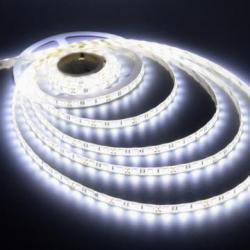HowtoTroubleshoot

How to Troubleshoot and Fix a LED Strip
If your LED strips is not functioning or stops working after some time, don’t worry! This guide will help you identify the problem and potentially fix it.
Testing a LED Strip
Power Supply Test
- Start by disconnecting the LED strip from the 12V or 24V power supply, including controllers, dimmers, amplifiers, and LED strips themselves.
- Use a voltmeter or multimeter to measure the output voltage with no load. You should get either 12V or 24V, depending on the transformer used.
- If the reading is zero or the voltage fluctuates between 0 and 12/24V, it means the transformer is faulty and needs replacement.
LED Ribbon Test
To test the LED strip alone without a controller, dimmer, or amplifier, follow these steps:
- Connect the ribbon directly to the power supply’s V+ (positive) and V- (negative) terminals, using 12V or 24V.
- For a white or single-color strip, connect the red wire to V+ and the black wire to V-.
- For a variable white strip (CCT), connect the red wire to V+ and the white and yellow wires to V-.
- For an RGB strip, connect the black wire to V+ and the red, green, and blue wires to V-.
- For an RGBW strip, connect the black wire to V+ and the red, green, blue, and white wires to V-.
- For a variable RGB + white strip (RGBCCT), connect the black wire to V+ and the red, green, blue, white, and yellow wires to V-.
- Note: For dynamic effect strips, refer to the specific guide associated with it as this testing method may not apply.
- If the strip lights up completely, it means the power supply and ribbon are not causing the malfunction. The issue may lie with the dimmer, controller, or amplifier.
- If the strip does not light up, check the following:
- Confirm the correct + and – polarity of the connections.
- Ensure the wires are securely inserted in the terminal block.
- Gently wave the strip along its entire length, including at the starting connection point, to check for any bad contact.
If the led lights for room still does not light up, it is likely defective and needs replacement. However, if it turns on and off during the waving motion, there may be a bad contact issue.
Repairing a LED Strip
Repair of a LED Strip with Bad Contacts
Bad contacts are a common issue with LED strips and can occur due to incorrect tape installation, rough handling, or temperature changes over time. When the semi-rigid PCB part of the strip expands and contracts, it can lead to micro-cracks in the solder joints and result in bad contacts.
- If the bad contact is at the beginning of the strip, you can fix it by following these steps:
- Gently peel off the heat-shrink tubing (white or black plastic).
- Unsolder the wires and resolder them properly.
- If available, reapply heat shrink tubing. If not, use electrician’s tape to secure the connections.
- If the bad contacts occur in the middle of the strip, you will need to remove the defective section, generally in groups of 3 or 6 LEDs:
- Cut the strip at the indicated cut-out locations, using scissors or a cutter. Make sure to cut in the middle of the copper tracks.
- Place the two pieces of ribbon next to each other.
- Connect them using short wires for soldering.
Repair of a LED Strip with Missing Colors or Different Shades
Multicolor RGB, RGBW, or variable RGB+white LED strips should have consistent colors throughout their length. If certain sections have different colors, it indicates a problem with the wiring or broken solder on the PCB.
- To identify the issue, light up the strip successively in red, green, and blue.
- If any of the three colors do not work at all, check the connection of the corresponding wire or the starting solder. Ensure that the wires at the controller output are properly connected. If needed, remove the heat-shrink tubing and redo the soldering.
- If only specific sections do not light up in any of the three colors, follow the steps mentioned earlier to remove the damaged section.
Repairing Peeling Tape
LED strips can experience tape peeling over time, especially in high humidity conditions. To fix this issue, you can apply a small amount of translucent silicone on the back of the best LED light strips. Avoid using strong glue that could damage the tape and cause poor contact.
Remember, troubleshooting and fixing LED strips may require some technical skills. If you’re unsure or uncomfortable attempting the repairs yourself, it’s best to seek professional assistance to avoid further damage.


